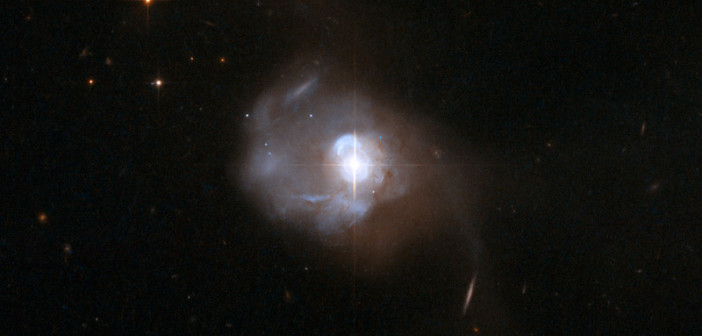Could a pair of supermassive black holes (SMBHs) be lurking at the center of the galaxy Mrk 231? A recent study finds that this may be the case — and the unique spectrum of this galaxy could be the key to discovering more hidden binary SMBH systems.
Where Are the Binary Supermassive Black Holes?
It’s believed that most, if not all, galaxies have an SMBH at their centers. As two galaxies merge, the two SMBHs should evolve into a closely-bound binary system before they eventually merge. Given the abundance of galaxy mergers, we would expect to see the kinematic and visual signatures of these binary SMBHs among observed active galactic nuclei — yet such evidence for sub-parsec binary SMBH systems remains scarce and ambiguous. This has led researchers to wonder: is there another way that we might detect these elusive systems?
A collaboration led by Chang-Shuo Yan (National Astronomical Observatories, Chinese Academy of Sciences) thinks that there is. The group suggests that these systems might have distinct signatures in their optical-to-UV spectra, and they identify a system that might be just such a candidate: Mrk 231.
A Binary Candidate

Proposed model of Mrk 231. Two supermassive black holes, each with their own mini-disk, orbit each other in the center of a circumbinary disk. The secondary black hole has cleared gap in the circumbinary disk as a result of its orbit around the primary black hole. [Yan et al. 2015]
Yan and her collaborators propose that the odd behavior of Mrk 231’s spectrum can be explained if the center of the galaxy houses a pair of SMBHs — each with its own mini accretion disk — surrounded by a circumbinary accretion disk. As the secondary SMBH orbits the primary SMBH (with a period of 1.2 years and a mass ratio of 38:1, according to the team’s models), it clears a gap in the circumbinary disk. The collaborators showed that this gap in the disk will cause a decrease in the continuum emission of the system consistent with the observed drop in Mrk 231’s UV spectrum.
If the collaboration’s models of Mrk 231 are confirmed, this would demonstrate the feasibility of finding other active binary SMBH systems by looking for similar deficits in the optical-to-UV spectra.
Citation
Chang-Shuo Yan et al. 2015 ApJ 809 117. doi:10.1088/0004-637X/809/2/117

1 Comment
Pingback: Morsels For The Mind – 28/08/2015 › Six Incredible Things Before Breakfast